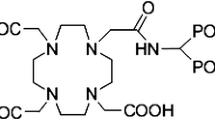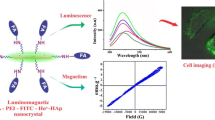Abstract
Hydroxyapatite is biocompatible and used in various biomedical applications. Here, we generated hydroxyapatite nanoparticles (HNPs) of various sizes (40–200 nm) and demonstrated that they can be stably loaded with drugs or radioisotopes by exploiting the high-affinity HA–(poly)phosphonate interaction. Clinically available phosphonates, clodronate, and Tc-99m-methylene-diphosphonate (Tc-99m-MDP), were efficiently loaded onto HNPs within 15 min. Biodistribution of radiolabeled HNP-MDP-Tc99m in mice was monitored non-invasively using microSPECT-CT. Imaging and dosimetry studies indicated that the HNPs, regardless of size, were quickly taken up by Kupffer cells in the liver after systemic administration into mice. Clodronate loaded onto HNPs remained biologically active and were able to result in selective depletion of Kupffer cells. This method of drug or isotope loading on HA is fast and easy as it eliminates the need for additional surface modifications of the nanoparticles.







Similar content being viewed by others
References
Barroug A, Glimcher MJ (2002) Hydroxyapatite crystals as a local delivery system for cisplatin: adsorption and release of cisplatin in vitro. J Orthop Res 20:274–280
Bernardi G (1973) Chromatography of proteins on hydroxyapatite. Methods Enzymol 27:471–479
Chuah MK, Schiedner G, Thorrez L, Brown B, Johnston M, Gillijns V, Hertel S, Van Rooijen N, Lillicrap D, Collen D, VandenDriessche T, Kochanek S (2003) Therapeutic factor VIII levels and negligible toxicity in mouse and dog models of hemophilia A following gene therapy with high-capacity adenoviral vectors. Blood 101:1734–1743
Coleman RE (2001) Metastatic bone disease: clinical features, pathophysiology and treatment strategies. Cancer Treat Rev 27:165–176
Doonan S (2004) Chromatography on hydroxyapatite. Methods Mol Biol 244:191–194
Dumbleton J, Manley MT (2004) Hydroxyapatite-coated prostheses in total hip and knee arthroplasty. J Bone Joint Surg Am 86A:2526–2540
Fleisch H, Russell RG, Bisaz S, Casey PA, Muhlbauer RC (1968) The influence of pyrophosphate analogues (diphosphonates) on the precipitation and dissolution. Calcif Tissue Res 2 (Suppl 1):10–10a
Fleisch H, Russell RG, Francis MD (1969) Diphosphonates inhibit hydroxyapatite dissolution in vitro and bone resorption in tissue culture and in vivo. Science 165:1262–1264
Gorbunoff MJ (1985) Protein chromatography on hydroxyapatite columns. Methods Enzymol 117:370–380
Grillenberger KG, Glatz S, Reske SN (1997) Rhenium-188 labeled hydroxyapatite and rhenium-188 sulfur colloid. In vitro comparison of two agents for radiation synovectomy. Nuklearmedizin 36:71–75
Grimes JS, Bocklage TJ, Pitcher JD (2006) Collagen and biphasic calcium phosphate bone graft in large osseous defects. Orthopedics 29:145–148
Itokazu M, Sugiyama T, Ohno T, Wada E, Katagiri Y (1998) Development of porous apatite ceramic for local delivery of chemotherapeutic agents. J Biomed Mater Res 39:536–538
Jung A, Bisaz S, Fleisch H (1973) The binding of pyrophosphate and two diphosphonates by hydroxyapatite crystals. Calcif Tissue Res 11:269–280
Lewandrowski KU, Bondre SP, Wise DL, Trantolo DJ (2003) Enhanced bioactivity of a poly (propylene fumarate) bone graft substitute by augmentation with nano-hydroxyapatite. Biomed Mater Eng 13:115–124
Matsumoto T, Okazaki M, Inoue M, Yamaguchi S, Kusunose T, Toyonaga T, Hamada Y, Takahashi J (2004) Hydroxyapatite particles as a controlled release carrier of protein. Biomaterials 25:3807–3812
McEwan AJ (2000) Use of radionuclides for the palliation of bone metastases. Semin Radiat Oncol 10:103–114
Mizushima Y, Ikoma T, Tanaka J, Hoshi K, Ishihara T, Ogawa Y, Ueno A (2006) Injectable porous hydroxyapatite microparticles as a new carrier for protein and lipophilic drugs. J Control Release 110:260–265
Moghimi SM, Szebeni J (2003) Stealth liposomes and long circulating nanoparticles: critical issues in pharmacokinetics, opsonization and protein-binding properties. Prog Lipid Res 42:463–478
O’Duffy EK, Clunie GP, Lui D, Edwards JC, Ell PJ (1999) Double blind glucocorticoid controlled trial of samarium-153 particulate hydroxyapatite radiation synovectomy for chronic knee synovitis. Ann Rheum Dis 58:554–558
Ostovic D, Stelmach C, Hulshizer B (1993) Formation of a chromophoric complex between alendronate and copper(II) ions. Pharm Res 10:470–472
Pandey U, Mukherjee A, Chaudhary PR, Pillai MR, Venkates M (2001) Preparation and studies with 90Y-labelled particles for use in radiation synovectomy. Appl Radiat Isot 55:471–475
Paul W, Sharma CP (2003) Ceramic drug delivery: a perspective. J Biomater Appl 17:253–264
Pratten MK, Lloyd JB (1986) Pinocytosis and phagocytosis: the effect of size of a particulate substrate on its mode of capture by rat peritoneal macrophages cultured in vitro. Biochim Biophys Acta 881:307–313
van Rooijen N, van Kesteren-Hendrikx E (2003) In vivo depletion of macrophages by liposome-mediated “suicide”. Methods Enzymol 373:3–16
Russell RG (2006) Bisphosphonates: from bench to bedside. Ann NY Acad Sci 1068:367–401
Saag KG (2003) Glucocorticoid-induced osteoporosis. Endocrinol Metab Clin North Am 32:135–157, vii
Schiedner G, Hertel S, Johnston M, Dries V, van Rooijen N, Kochanek S (2003) Selective depletion or blockade of Kupffer cells leads to enhanced and prolonged hepatic transgene expression using high-capacity adenoviral vectors. Mol Ther 7:35–43
Selby PL, Davie MW, Ralston SH, Stone MD (2002) Guidelines on the management of Paget’s disease of bone. Bone 31:366–373
Senior JH (1987) Fate and behavior of liposomes in vivo: a review of controlling factors. Crit Rev Ther Drug Carrier Syst 3:123–193
Shinto Y, Uchida A, Korkusuz F, Araki N, Ono K (1992) Calcium hydroxyapatite ceramic used as a delivery system for antibiotics. J Bone Joint Surg Br 74:600–604
Uchida A, Shinto Y, Araki N, Ono K (1992) Slow release of anticancer drugs from porous calcium hydroxyapatite ceramic. J Orthop Res 10:440–445
Uchtman V (1972) Structural investigations of calcium binding molecules. II. The crystal and molecular structures of calcium dihydrogen ethane-1-hydroxy-1,1-diphosphonate dihydrate, CaC(CH3)(OH)(PO3H)2.2H2O; implications for polynuclear complex formation. J Phys Chem 76:1304–1310
Unni PR, Chaudhari PR, Venkatesh M, Ramamoorthy N, Pillai MR (2002) Preparation and bioevaluation of 166Ho labelled hydroxyapatite (HA) particles for radiosynovectomy. Nucl Med Biol 29:199–209
Wahl DA, Czernuszka JT (2006) Collagen-hydroxyapatite composites for hard tissue repair. Eur Cell Mater 11:43–56
Wolff G, Worgall S, van Rooijen N, Song WR, Harvey BG, Crystal RG (1997) Enhancement of in vivo adenovirus-mediated gene transfer and expression by prior depletion of tissue macrophages in the target organ. J Virol 71:624–629
Worgall S, Leopold PL, Wolff G, Ferris B, Van Roijen N, Crystal RG (1997) Role of alveolar macrophages in rapid elimination of adenovirus vectors administered to the epithelial surface of the respiratory tract. Hum Gene Ther 8:1675–1684
Yeh HS, Berenson JR (2006) Treatment for myeloma bone disease. Clin Cancer Res 12:6279s–6284s
Zhang S, Gonsalves KE (1997) Preparation and characterization of thermally stable nanohydroxyapatite. J Mater Sci Mater Med 8:25–28
Zhang YF, Cheng XR, Chen Y, Shi B, Chen XH, Xu DX, Ke J (2007) Three-dimensional nanohydroxyapatite/chitosan scaffolds as potential tissue engineered periodontal tissue. J Biomater Appl 21:333–349
Zhu SH, Huang BY, Zhou KC, Huang SP, Liu F, Li YM, Xue ZG, Long ZG (2004) Hydroxyapatite Nanoparticles as a Novel Gene Carrier. J Nanopart Res 6:307–311
Acknowledgments
This work was supported by funds from the Fraternal Order of Eagles, Mayo Clinic Cancer Center, Mayo Foundation and the School of Materials Engineering, Nanyang Technological University.
Author information
Authors and Affiliations
Corresponding author
Rights and permissions
About this article
Cite this article
Ong, H.T., Loo, J.S.C., Boey, F.Y.C. et al. Exploiting the high-affinity phosphonate–hydroxyapatite nanoparticle interaction for delivery of radiation and drugs. J Nanopart Res 10, 141–150 (2008). https://doi.org/10.1007/s11051-007-9239-1
Received:
Accepted:
Published:
Issue Date:
DOI: https://doi.org/10.1007/s11051-007-9239-1




